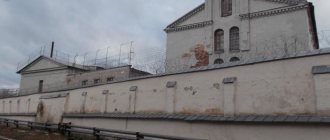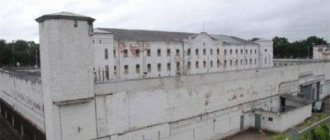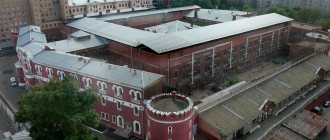White Swan
The maximum security correctional colony is located in the city of Solikamsk, Perm Territory, and dates back to 1938. Among all the correctional colonies in Russia, “White Swan” is distinguished by a particularly strict regime for keeping prisoners.
Criminals sentenced to life imprisonment are sent here. The chambers are designed for one, two and three people. There is a library, and since the colony is a correctional colony, a psychologist works with each prisoner.
There are many versions of the origin of the unofficial name, but the most plausible of them is based on the method of movement of prisoners. Criminals move around the colony, bending forward at 90 degrees, with their arms behind them. A peculiar “swan” pose. Despite its severity, the White Swan colony meets international standards for the detention of criminals.
2
From Elban to Milan
Maxim Kiselev. Photo: Website www.mzk1.ru
Not inferior to Lozhkin in terms of the number of victims is another convict of Snezhinka, a resident of Novokuznetsk, Maxim Kiselev. In 2009, he, along with his partner Anastasia and their one-year-old daughter, arrived in the village of Orton to celebrate February 23 - Defender of the Fatherland Day, and at the same time meet the relatives of his chosen one.
On this occasion, Anastasia’s parents arranged a feast, which turned into a quarrel: the girl’s father began to scold Kiselev for beating Anastasia. In response to this, the enraged guest committed a terrible massacre in the house, not even sparing an eight-year-old boy. Kiselyov still places all the blame for his crime on counterfeit alcohol: he allegedly got drunk and suffered a memory loss, which is why he committed mass murder.
During his time in Black Golden Eagle, Kiselev became a “star” - he starred in the documentary film by Italian director Mark Franchetti “Condemned. Colony number 56." After this, the convict received letters from all over the world. One of them became fateful: Kiselev met an Italian woman named Serena, with whom he plans to tie the knot in the near future. Serena even agrees to move to Khabarovsk from Milan.
Together with Kiselev, while away his life in the village of Elban, former drug addict Dmitry Dilschneider, nicknamed Novosibirsk Raskolnikov, at whose hands five elderly residents of Novosibirsk died in 2007. He attacked pensioners for profit, killing them with a hammer and a screwdriver, after which he took away all the valuables and remaining pensions from the victims. Dilschneider tried to challenge his life sentence through the Supreme Court - however, unsuccessfully.
Black Dolphin
One of the oldest colonies in Russia, founded back in 1773 near the town of Sol-Iletsk in the Orenburg region. It houses life-sentenced prisoners, and a special regime operates within the correctional facility. It is believed that this is the most terrible prison in Russia.
The first life-long prisons began to appear on the map of the Orenburg region during the reign of Catherine II. The first to try their cameras were participants in the Pugachev uprising. It received its popular name from the fountain that operates in the courtyard of the institution.
The daily routine is strictly regulated, and the radio is on almost constantly. Prisoners' walks take place in a special cell, and not in the yard. It is slightly larger than the cells in which prisoners are kept.
By the way, on our website most-beauty.ru you can find out which institutions are in the TOP 10 most luxurious prisons in the world in this interesting article.
3
Butyrka
Butyrka prison dates back to the times of Catherine II. In those years, the small Butyrsky farm, where military units were located, had its own prison, where state traitors and rebels were kept. Now such people are called extremists. The most famous rebel was Emelyan Pugachev, in whose honor one of the towers of the current prison is named. Nowadays, Butyrka has the status of the largest pre-trial detention center in the country. The prison does not have the best reputation among similar “institutions” regarding escapes. In Soviet times, escaped prisoners were not officially reported and such news was not disseminated, but in pre-revolutionary and post-Soviet times one often heard about escaped prisoners. Famous prisoners: Zhanna Aguzarova, Evgeny Ginzburg, Vyacheslav Datsik, Vladimir Mayakovsky, Felix Dzerzhinsky, Nestor Makhno and others.
polar owl
Located in the village of Kharp in the Yamal-Nenets Autonomous Okrug on the picturesque bank of the Sob River. The colony opened for life prisoners in 1961, and its first prisoners worked on the construction of the Trans-Siberian Railway.
In those days, there were worse living conditions here, since the buildings of the institution were poorly suited for human habitation. In 2004, it received the status of a colony where especially dangerous criminals serve their life sentences.
Loud scandals are associated with the institution. The latest ones, 2012-2013, are associated with the fact that colony employees falsified confessions and exerted physical and psychological pressure to extract testimony.
4
The zone where people recognize by their eyes
Security at Snezhinka is at the proper level. Photo: Website www.mzk1.ru
“Snezhinka” is distinguished from other special regime zones by the fact that there are few service dogs on its territory - Rottweilers, shepherd dogs and golden retrievers trained for drugs. There is simply no point in keeping a lot of them in Elban: along the perimeter of IK-6 there are ultra-sensitive motion sensors and numerous video surveillance cameras - there are more than a thousand of them in Snezhinka. Moreover, the camera lenses capture not only the territory of the zone, but also the village in which it is located. Data from surveillance devices is fed to monitors that are constantly monitored by prison guards.
There is an additional cage inside each Snezhinka cell, and guards in IK-6 are on duty on all floors without exception. It is virtually impossible to escape from there: to leave the territory of the zone, an electronic pass is not enough - the entrances and exits to the colonies are equipped with special equipment that scans the retinas of the jailers’ eyes. In addition, “Snowflake” is the most illuminated object in Elban, and the bright light makes every nook and cranny visible.
By the way, by prison standards, service in Snezhinka is quite prestigious: the salaries are high, and a year of work is counted as two. In addition, employees of IK-6 have the right to further training at the Kuzbass Institute of the Federal Penitentiary Service (FSIN) in Novokuznetsk. People often come to work for the zone in Elban from other settlements of the Far East, for which there is a dormitory on the territory of Snezhinka.
Due to the very high level of security in IK-6, prisoners are driven around the colony without handcuffs. However, such humane conditions are not appreciated by all “wads” - that’s what people sentenced to life are called in prison jargon. Some are dissatisfied with the remoteness of the colony: this makes it difficult for relatives to come for visits, and letters sometimes take a month or a month and a half to reach the addressee. By the way, all mail must be censored by jailers, because the likelihood that the letters will contain something forbidden is very high. Only letters from lawyers are not opened in IK-6.
And some prisoners in Snezhinka are not satisfied with the strict rule of this zone: all convicts are required to work, regardless of their desire. The colony has workplaces where prisoners do sewing and woodworking.
Butyrka prison
Perhaps one of the most famous Russian prisons, founded in 1771. The largest prison in the Russian capital, and the building itself is included in the list of architectural monuments.
After the Bolsheviks came to power, it was transformed into a transit prison, and during the period of Stalinist repressions there were up to 170 people in one cell. Among the celebrities sitting here were Varlam Shalamov, designer Sergei Korolev, and Nobel Prize laureate Alexander Solzhenitsyn.
History has also recorded the famous escapes from Butyrka. In 1996, the first female escape occurred when 26-year-old Natalya Sorokozherdeva managed to escape the security perimeter.
5
Pskov Prison Castle
Modern name: FKU SIZO-1 Federal Penitentiary Service of Russia for the Pskov Region - SIZO-1 Pskov
Capacity: 377 seats
From the history:
Built in 1805. From the very beginning, the rules of detention here were established. It was forbidden to have writing materials. Letters were not sent or received under any circumstances. There was no library either. It was not allowed to read one's own books without first viewing them by the priest and the prison warden, and one was not allowed to play musical instruments. In addition, one could forget about smoking, gambling, checkers, cards, swearing, loud laughter, and drinking alcohol were prohibited. Dating was very limited. Transmissions were not accepted.
Interesting things:
Nowadays there is a pre-trial detention center, on the territory of which the Church of St. Anastasia the Pattern Maker was built in 2000. Services in the church are held almost every week, and in April 2015 a church marriage was registered here.
Lefortovo prison
There are special prisons in Russia, and the prison in Lefortovo is one of the most closed institutions of this type. In fact, now it is a pre-trial detention center in which dangerous criminals are awaiting sentencing.
It was formed in 1881, and lower ranks of the Russian army who committed crimes of varying severity served their sentences there. In the 20s of the twentieth century, it was converted into a prison where criminals were kept, for whom execution was replaced by imprisonment for a period of 10 years.
The contents in Lefortovo are quite harsh. Relatives are denied visits, and until 2021 there was no hot water. It is almost impossible to find out what is happening in Lefortovo, since journalists are not allowed outside the perimeter.
6
"Snowflake"
From the Khabarovsk Territory, where a new prison for lifers is located, prisoners are heard complaining about the roar of fighter jets from Komsomolsk-on-Amur. But this is not their only problem, because it is impossible to escape from pre-trial detention center-4. People argue about which prison is the worst in Russia, and since 2014, the majority have named “Snezhinka”. In 2012, construction ended, and 2 years later the building was put into operation. Pre-trial detention center-4 frightens prisoners not only because of its “pleasant” neighborhood (pedophiles, maniacs, murderers, terrorists), but also because of its perfect security system.
The prison is equipped with motion sensors, CCTV cameras at every turn, and doors are opened using retinal scans of staff. The colony received its name due to the location of the buildings. Seven buildings stand in such a way that if you look at photographs taken from above, you can see a snowflake. It has space for 378 prisoners, who will be housed in 144 cells. The first criminals were brought in from the Black Golden Eagle in 2021, and this colony was closed.
The daily routine is the same as in “Black Dolphin”. In their free time from work, criminals read, play chess, and watch TV. They have access to the prison store where they can buy sweets. The limit for the first 10 years is 6 thousand rubles. This money needs to be earned. Among the prisoners: Stanislav Tishchenko - a bandit from the 90s, Alexander Lozhkin - a mass murderer in the Middle Urals, Maxim Kiselev - a thug from Novokuznetsk.
Sailor's silence
The penitentiary institution received its seemingly romantic name from the name of the street, Matrosskaya Tishina, on which it is located.
This place in Moscow has a long history. A Strait House was founded here in 1775, and literally a year later it was converted into a prison. In the first years of Soviet power, minors were kept in the building, and then the institution served as a detention facility for especially dangerous criminals. In 1956, it began to perform the functions of a pre-trial detention center.
It became famous in the 90s, when leaders of gangster groups were kept there. Sergei Mavrodi served his sentence here for financial fraud.
7
First short date
By sending a person to a pre-trial detention center, the state assumes that he will be isolated from connections with the outside world. By law, the investigator can allow visits with relatives once every two months. Dating takes place without physical contact, through glass, as in American films. The conversation is broadcast through the handsets of interconnected phones.
“The investigator froze me for a long time; I didn’t have a date for three or four months,” says Alexander Margolin. “Then they started giving.” They came in turn - my wife and children and my parents. Whether it was necessary to take children to prison is a difficult question for me. This greatly depends on age, on how children perceive it all. Heavily depends on the pre-trial detention center. The “Matrosskaya Tishina” has a huge hall, and the “Butyrka” hall is also more or less decent. At Vodnik there are only cages, and prisoners also smoke. The volume is small - if you go on a date in the second group, and not in the first, then it is inhaled and smoky, there is no oxygen. Dating is, of course, an emotional blow. At Vodnik there were dates in the morning. Until about three or four o'clock I felt sick, then I fell asleep, woke up for the evening check, and after that I went back to sleep. In fact, the day was gone.
Illustration: Alina Kugusheva for OVD-Info
Dmitry Borisov had his first date with his mother:
I was very happy, of course. You are taken to another building, first you hang out at the assembly, wait until you are called into the booth where the date is taking place. You're a little worried. Many people start to feel sad after a date. Some even refuse a date because they are overwhelmed by negativity. It happened to me, but it was a slight sadness. Bluesy light sadness. A date is a breath of freedom; you get a lot of energy from free people. Mom was worried whether they were beating me or wiping the floor with me. Well, mom is always like that.
Crosses
The St. Petersburg “Crosses” also stand out for their strict content. They were founded in 1892, and in 2021 the prisoners were transferred to new buildings located in Kolpino. The uniqueness is that there are covered passages between the buildings with cameras.
Looking at the Old Crosses, it is difficult to imagine that this is a place where prisoners are kept. The beautiful red brick building looks more like an architectural monument. The cells remember their famous inmates, among whom were Marshal Konstantin Rokossovsky, actor Georgy Zhzhenov, and poetess Anna Akhmatova stood in lines for hours to see her son.
There have been three famous escapes throughout history. The most resonant was the escape of Lyonka Panteleev in 1922.
8
People
A pre-trial detention center is an amazing place where you will meet amazing people whom you would hardly meet in your free life. Persons involved in high-profile criminal cases always become the heroes of the news, and sometimes even entire media campaigns. Today you will see on TV a fight between football fans and police in Biryulyovo, and in a week the accused in this case will cross the threshold of your hut. But even without celebrities from crime chronicles, the pre-trial detention center is a kaleidoscope of lives. Guilty and innocent, murderers and smugglers, choreographers, mayors, prefects, lawyers, activists and everyone.
Ismail Ramazanov says that in every cell of the Simferopol pre-trial detention center in which he was sitting, there was one of the Crimean Tatar political prisoners. He heard about some of them while he was still free, and he even met the Ukrainian taekwondo champion Uzeir Abdullaev at sports training camps. In the pre-trial detention center, Abdullaev was very ill, and Ismail tried to help him, demanding that the FSIN bring a doctor. But no medical assistance was provided. Ramazanov believes that he was transferred from this cell to another precisely because of constant complaints about the absence of a doctor.
The defendant in the “Bolotnaya case”, Alexander Margolin, ended up in Moscow pre-trial detention center No. 5 “Vodnik” already with experience of administrative arrest for the action on December 5, as well as after 12 days in a temporary detention center and ten days in a quarantine cell. When he got to the hut, where he spent the next year, the effect of novelty had already worn off.
“There was no overcrowding, 8 people at first, then they added a bunk, so there were 14,” Margolin recalls. - Cellmates as usual: 228th - drugs, one scammer, someone has a “hooligan”. Mostly visitors. There was one Balt, they took him with cocaine. Although he was more on a different topic - he was carrying cigarettes to the European Union. It was interesting to talk to him. There was also a Kyrgyz man. He was a plastic surgeon, then he got into a car accident, broke his arms and went into fraud. We played a lot of chess.
Alexey Gaskarov, once in the cell, was faced with a strong desire of the TsPE operatives to find out who ordered the pogrom in Khimki. Various people came to Gaskarov and introduced themselves as “thieves” or “authorities.” They asked how much he was paid, said that someone should “answer for the lawlessness” and that “the gang of thieves is concerned about the bustle in Khimki,” and that this “bubble” provoked police activity, which is why the thieves are suffering losses.
This is how the conflict with the inmates is described in Pyotr Silaev’s book “Correspondent Gaskarov in Hell and Other Stories”:
Gaskarov began to wait for the black mark - and very soon it knocked on the window. On the “road” a note arrived, officially notifying him that a “serious conversation” would take place with him today in the exercise yard. Lesha looked around his cell. It was stupid, funny and disgusting - could this really be the end?
But no “serious conversation” happened, because an international campaign began in defense of the “Khimki hostages” and the pressure on Gaskarov in the pre-trial detention center stopped.
Vladimir Central
They knew about the famous Russian prison before, but after Mikhail Krug’s song, it became even more popular. The prison was built by decree of Empress Catherine II to hold state criminals, and in 1906 it began to be called “central”.
Now the historical building houses pre-trial detention center No. 1 in the city of Vladimir. After the overthrow of tsarism, it continued to serve as special camps and prisons for especially dangerous state criminals. Strict containment rules were established within the central area.
In 1996, on the initiative of the director of the Vladimir-Suzdal Nature Reserve, a museum began operating on the territory, which houses valuable exhibits of famous prisoners.
9
The oldest operating prisons and pre-trial detention centers in Russia (38 photos)
Year of foundation: 1768;
Capacity - 78 seats;
Built on the site of a city fortress founded in the 16th century, the thickness of the walls of the chambers reaches 1 meter. According to legend, the prisoners once saved the city during a fire - they broke into a burning powder warehouse and lowered barrels of gunpowder into the Oka River. During the repressions of the 1930s. clergy of the Russian Orthodox Church were kept in prison.
4. Butyrka (FKU pre-trial detention center No. 2 of the Federal Penitentiary Service for Moscow).
Year of foundation: 1771;
Capacity - 2700 seats;
It was erected according to the design of the architect Matvey Kazakov on the site of a soldier's castle-fortress. It was used as the central prison of Moscow and as the largest transit point in the Russian Empire. In 1908, the famous illusionist Harry Houdini, performing in Butyrka, took 28 minutes. got out of the “transport box” for prisoners;
Famous prisoners - Emelyan Pugachev, Vladimir Mayakovsky, Felix Dzerzhinsky, Nestor Makhno, Osip Mandelstam, Sergei Korolev, Varlam Shalamov, Alexander Solzhenitsyn, Sergei Mavrodi.
5. Vladimir Central (FKU T-2 Federal Penitentiary Service for the Vladimir Region).
Year of foundation: 1783;
Capacity - 1220 seats;
Built by decree of Empress Catherine II as a “workhouse” for petty thieves, in 1906 it became a central prison - a particularly fortified place of imprisonment with strict internal regulations. In the 1950s in solitary confinement there were “nameless” prisoners kept under numbers (relatives of Joseph Stalin, former leaders of the Baltic countries). Currently a maximum security prison;
Famous prisoners - Mikhail Frunze, Vasily Stalin, Francis Gary Powers, Janos Kadar, Vladimir Bukovsky.
6. Stary Oskol prison (FKU pre-trial detention center No. 2 of the Federal Penitentiary Service for the Belgorod region).
Year of foundation: 1795;
Capacity - 275 seats;
It is located in the government building, erected by decree of Empress Catherine II, one of the oldest stone buildings in the city. Initially, the city treasury, a guardhouse with prison cells, wine warehouses, a zemstvo court, an archive and the mayor’s apartment were located there. The building was rebuilt many times, and by 1862 it was completely turned into a prison. In 1967 it was converted into a pre-trial detention center.
7. Pskov prison castle (FKU pre-trial detention center No. 1 of the Federal Penitentiary Service for the Pskov region).
Year of foundation: 1805;
Capacity - 377 seats;
Built according to a standard design for a government building by architect Andreyan Zakharov on the site of a wooden fort, expanded in 1869, and built on in 1888. The regime of detention was quite strict - prisoners were forbidden to have ink, pencils and paper in their cells. Currently, like a significant part of similar institutions, it is a pre-trial detention center.
8. Civil Prison (FKU Pre-trial Detention Center No. 2 of the Federal Penitentiary Service for the Chuvash Republic).
Year of foundation: 1809;
Capacity - 312 seats;
The historical building was built on the site of a wooden prison that was part of a military fortress;
According to local legend, when Catherine II was traveling from Cheboksary to Kazan via Tsivilsk, a boy threw a stone at her carriage. The Empress ordered to find the hooligan and put him in prison - so the boy became the youngest prisoner. Today, correctional institutions (pre-trial detention centers and two colonies) are actually the city-forming institutions for Tsivilsk.
9. Yaroslavl Central (FKU pre-trial detention center No. 1 of the Federal Penitentiary Service for the Yaroslavl region).
Year of foundation: 1810;
Capacity - 1000 seats;
The prison was erected in Korovnitskaya Sloboda at the suggestion of Yaroslavl Governor-General Alexei Melgunov. It served as a transit point for prisoners being transferred to Siberia. After the revolution, participants in peasant uprisings, counter-revolutionaries, and hierarchs of the Russian Orthodox Church were kept in "Korovniki". Since 1964 - regional detention center;
Famous prisoners are former Minister of War of the Provisional Government Alexander Verkhovsky, security officer Vyacheslav Menzhinsky, common-law wife of Admiral Kolchak Anna Timireva.
10. Minusinsk prison (FKU Prison GUFSIN in the Krasnoyarsk Territory).
Year of foundation: 1823;
Capacity - 1000 seats;
One of the oldest and largest penitentiary institutions in Siberia. Built as a transit prison for prisoners sentenced to exile; The stone building was completed in 1912. In Soviet times, it became an “executive” prison - death sentences were carried out on the territory of the prison. Currently, persons who have committed particularly serious crimes and terrorist attacks, repeat offenders, as well as leaders of criminal communities are serving their sentences here;
Famous prisoners are the Decembrists Vasily Davydov, Nikolai and Pavel Bobrishchev-Pushkin, and the revolutionary Yuli Martov (Zederbaum).
11. Ekaterinburg Central (FKU pre-trial detention center No. 1 of the Federal Penitentiary Service for the Sverdlovsk Region).
Year of foundation: 1830;
Capacity - 1800 seats;
The prison castle was erected according to the design of the architect Mikhail Malakhov, one of the authors of St. Isaac's Cathedral in St. Petersburg. In Soviet times - one of four "executive" prisons - with death rows and a place for executions. In 1945-1954. several solitary confinement cells housed Nazi criminals;
Famous prisoners include Yakov Sverdlov, personal adjutant of Hitler Otto Günsche.
12. Oryol Central (FKU pre-trial detention center No. 1 of the Federal Penitentiary Service for the Oryol region).
Year of foundation: 1840;
Capacity - 200 seats;
The prison company building is one of the oldest in the city. In 1908, one of the largest convict prisons in Tsarist Russia was built on its basis, which was distinguished by very harsh conditions for prisoners. During the Great Patriotic War, the Germans turned the prison into a concentration camp for partisans. Today it is a regional detention center and prison hospital for patients with tuberculosis;
Famous prisoners - Felix Dzerzhinsky, Grigory Kotovsky.
13. Krasnoyarsk prison (FKU pre-trial detention center No. 1 of the Federal Penitentiary Service for the Krasnoyarsk Territory).
Year of foundation: 1850;
Capacity - 1500 seats;
Because of the color of the walls, the stone building of the prison castle received the nickname “White Swan” in the city (not to be confused with the colony for life prisoners in Solikamsk, Perm Territory, the pre-trial detention center of Pyatigorsk and Veliky Novgorod). The transit prison was expanded and rebuilt several times. In the 1970s turned into a pre-trial detention center. In 2006, a new building was put into operation; in 2015, the detention center won the FSIN competition for the best correctional institution in Russia;
Famous prisoners - Joseph Stalin, Yakov Sverdlov, Georgy Zhzhenov, Ariadna Efron, Alexander Maslyakov.
14. Kashinskaya prison (FKU pre-trial detention center No. 2 of the Federal Penitentiary Service for the Tver region).
Year of foundation: 1855;
Capacity - 139 seats;
It was built on the site of a wooden prison that had fallen into disrepair, which had existed since the city’s inception. It was distinguished by strict conditions; From 1953 to 1961, those sentenced to 25 years in prison served their sentences in prison. Today it is used as a detention center;
Famous prisoners are members of the State Emergency Committee.
15. Chistopol prison (FKU pre-trial detention center No. 5 of the Federal Penitentiary Service for the Republic of Tatarstan).
Year of foundation: 1856;
Capacity - 200 seats;
Built as a transit facility, after the October Revolution of 1917 it came under the control of the NKVD; foreigners and especially dangerous political criminals were kept in the prison. Before the 1980 Olympics, a significant portion of prisoners from the cities of the Golden Ring of Russia were transferred here. Since 2005 - pre-trial detention center.
16. Irkutsk prison (FKU pre-trial detention center No. 1 of the Federal Penitentiary Service for the Irkutsk region).
Year of foundation: 1861;
Capacity - 1200 seats;
Until 1900, it was the only stone building in the city’s Workers’ Suburb; it was called the “White Swan” because of the color of the walls. It was one of the most overcrowded in the Russian Empire: in a building designed for 400 prisoners, at the beginning of the 20th century up to 2,000 people were kept. The bulk of the prisoners were those convicted of murder;
A well-known prisoner is one of the leaders of the White movement, Alexander Kolchak.
17. Yenisei Prison (FKU Prison No. 2 of the Federal Penitentiary Service for the Krasnoyarsk Territory).
Year of foundation: 1865;
Capacity - 150 seats;
It was built to replace the former prison, located in another part of the city on the site of a prison, which, in turn, appeared in Yeniseisk back in 1647. Since the last third of the 19th century, a significant part of the prisoners were political. In Soviet times, it had the status of “executive” (death sentences were carried out in prison). Today, the old building operates as a pre-trial detention center, the new one is a special regime prison for especially dangerous repeat offenders and extremists;
Famous prisoners - Socialist Revolutionary terrorist Grigory Gershuni, Joseph Stalin.
18. Lefortovo prison (FKU pre-trial detention center No. 2 of the Federal Penitentiary Service of Russia).
Year of foundation: 1881;
Capacity - 200 seats;
The prison was built according to the design of the architect P. Kozlov, initially it housed lower ranks who were sentenced to short terms. After the October Revolution of 1917 - a special prison for especially dangerous criminals, in 1992-2005. - pre-trial detention center of the FSB of the Russian Federation. In 2006, it came under the jurisdiction of the Federal Penitentiary Service;
Famous prisoners - Alexander Solzhenitsyn, Eduard Limonov, Matias Rust, Salman Raduev, Valeria Novodvorskaya, Vladimir Kvachkov.
19. Verkhneudinsk pre-trial detention center (FKU pre-trial detention center No. 1 of the Federal Penitentiary Service for the Republic of Buryatia).
Year of foundation: 1886;
Capacity - 100 seats;
Built as a Verkhneudinsk prison castle for especially dangerous criminals. During the repressions of the 1930s. was the main transit prison of YuzhLAG, later it functioned as a distribution point for Japanese prisoners of war. Since 1964 - pre-trial detention center;
Famous prisoners are generals of the Japanese Kwantung Army, Irina Khakamada’s father is Mutsuo Khakamada.
20. Crosses (FKU pre-trial detention center No. 1 of the Federal Penitentiary Service for St. Petersburg and the Leningrad Region).
Year of foundation: 1892;
Capacity - 2000 seats;
It was built on the site of an old correctional prison according to the design of the architect academician Antoni Tomishko in the form of two five-story cruciform buildings with solitary cells for especially dangerous state criminals. Currently a pre-trial detention center. In 2007-2015 new buildings for 4,000 places were erected in Kolpino, where it is planned to transfer the institution;
Famous prisoners - Grand Duke Nikolai Mikhailovich, Alexander Kerensky, Leon Trotsky, Daniil Kharms, Lev Gumilyov, Joseph Brodsky.










